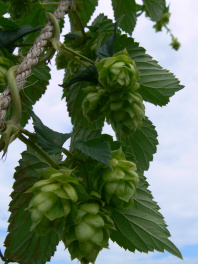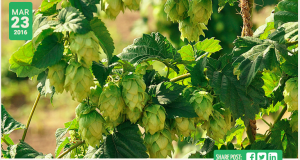By: Evan Elford – New Crop Specialist | OMAF/MRA | ONspecialtycrops | September 26, 2014
 As hop growers across the province finish harvest and post-harvest activities, autumn presents the time for a few final management practices in the hop yard before the onset of winter. Here are a few activities to consider for your ‘to-do’ list this fall:
As hop growers across the province finish harvest and post-harvest activities, autumn presents the time for a few final management practices in the hop yard before the onset of winter. Here are a few activities to consider for your ‘to-do’ list this fall:
- Dead bines and remaining debris which have dried down through the autumn should be cut at the soil level and removed from the yard.
- Apply and incorporate compost or composted manure to the hills. If using a mechanical process to incorporate the amendments, set implements to direct the soil mixture towards the hop crowns. Note: Raw manure (untreated animal excrement with or
without bedding) is best applied in spring to established plants when the crop begins to grow in order to maximize the use of nutrients and minimize environmental impact. For more information on nutrient values of manure and compost please visit the OMAFRA website at:http://www.omafra.gov.on.ca/english/crops/pub811/9manure.htm - Complete an inventory of diseased and less vigorous plants (marked during the growing season) and submit orders for replacement plant material through the winter. These crowns can be removed in either the fall or early spring.
- Flush and drain irrigation lines to remove sediment and to prevent breakage of lines/emitters during the winter.
- Once plants are completely dormant, mulch (e.g. straw) can be applied to the rows if desired. Mulch can help moderate winter temperatures, minimize desiccation of crowns, prevent frost heaving of crowns during winter thaws or in the early spring and, as it breaks down, can provide valuable organic matter to the soil. Mulch can also provide some measure of weed prevention during the growing season by acting as a barrier – but watch out, if the straw is not completely clean of seed, volunteer wheat or oats may become a nuisance in the following growing season.
- Inspect trellis and anchors for loose or missing parts and perform any required maintenance in the fall or early spring.
When all is said and done, the autumn activities should prepare you to hit the ground running when those hop shoots start emerging next year – yup, spring is just around the corner!
To read the original article, please click here.
 Ontario Hop Growers' Association The OHGA is a not-for-profit association of hop growers, families and enthusiasts who are interested in supporting the growth of the hop industry in Ontario.
Ontario Hop Growers' Association The OHGA is a not-for-profit association of hop growers, families and enthusiasts who are interested in supporting the growth of the hop industry in Ontario.


